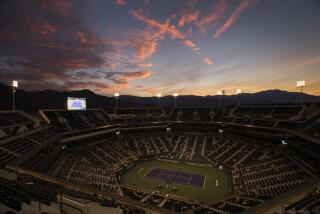This Tennis Stuff Is Not Everyone’s Cup of Tea
- Share via
This week in Davis Cup action, just to help sift through the confusion, Britain plays Israel in a Europe/Africa Zone Group I first-rounder, Mexico faces Ecuador in an Americas Zone Group I opener, Indonesia plays host to Uzbekistan in Asia/Oceania Zone Group I, Finland travels to Ghana in Europe/Africa Zone Group II, Brazil meets Colombia in Americas Zone Group II, Kuwait visits Iran in Asia/Oceania Zone Group II and, closer to home, the United States takes on Croatia in the World Group, which has nothing to do with any of the other groups, at least not until everybody regroups for next year.
Good to have that sorted out. Any other questions?
Of course there are. With Davis Cup, there’s always another question.
For instance, everyone now wondering what all these Croatians in short pants are doing milling around Carson this week might also be wondering, “What is the Davis Cup?”
No, it’s not an old dented spittoon filled with contributions for Al Davis from bitter L.A. Raider fans still angry that Davis pulled the team out of town 10 years ago.
(Although, come to think, that’s not such a bad idea.)
And, no, thankfully, it’s not an Ebay entry from the old Chili Davis Used Protective Gear Collection.
The Davis Cup, according to the Davis Cup media guide, is “the premier team competition in tennis.”
Cliff Drysdale, who called ESPN’s first Davis Cup match in 1979 and will be behind the mike for ESPN2 this week at the Home Depot Center, says the Davis Cup is “the best competition that tennis has, in my opinion, including the Slams. Because for those who do see Davis Cup, it’s the most compelling tennis that can be played because it gets people juiced up, much more than any individual competition, including the finals of the Grand Slams.
“Because [in the Slams] you’re watching two outstanding athletes, but it doesn’t mean as much as when you’ve got Germany playing Spain or USA playing against Australia in the finals. It’s not the same.”
So why aren’t more people juiced up about Los Angeles playing host to this first-round Davis Cup match against Croatia, which runs from Friday through Sunday?
How come more people can’t tell you who won the last five Davis Cups? Or even the last Davis Cup?
(Answer to that last one: Spain, which defeated the United States, 3-2, in the 2004 final in Seville. More than 27,000 crazed Spaniards turned out for matches on all three days. Not many really noticed back in the States though.)
In the United States, when most sports fans think of the Davis Cup, if they think of it at all, they see an anachronism, a nostalgia trip, a testament to the past. In that regard, it keenly represents how much of America views the sport of tennis today.
If you were to ask the average U.S. sports fan to rank the various cups in terms of current-day importance, the Davis Cup would be scuffling to keep its spot in the top 10.
The 2005 Cup Standings:
1. NASCAR Nextel Cup. The state of the sporting nation, for whatever it’s worth. It combines fast cars and over-the-top advertising, it’s repetitious and environmentally unfriendly, it’s a sedentary activity that resembles a big video game, and Americans dominate. No wonder America loves it.
2. World Cup. Only in America would the world’s most popular sports competition take a backseat to stock cars. But even motorheads can see the global importance. The 1994 World Cup filled football stadiums across the United States. And, bottom line: The Americans almost made the semifinals in the last one.
3. Ryder Cup. Golf’s premier team competition, and the golfers get it right: The Ryder Cup matches the United States against Europe, they hold it every other year, and it’s over in less than a week. Once, the Davis Cup format was very similar. The inaugural Davis Cup, held in 1900, involved only two teams, one from the United States, the other from the British Isles, and the U.S. won the trophy in three quick matches. For the Davis Cup, evolution hasn’t been a happy thing.
4. Presidents Cup. How popular has the Ryder Cup become? In 1994, they spun it off to cut the non-Europeans in on the action.
5. Breeders’ Cup. They say horse racing is a dying sport in the States. Maybe so. But gambling is here to stay.
6. Stanley Cup. Used to rank higher, but recent events have conspired to lessen the luster. That’s right, if a cup can be won by the Tampa Bay Lightning, how important can that cup be? First that, then the lockout. Spotted most recently standing in a bread line in Toronto.
7. America’s Cup. Once prestigious sailing competition no longer won by Americans. The Davis Cup can relate.
8. Davis Cup. Hanging in there, holding off the Solheim Cup, the Grey Cup, the Gold Cup and the 7-Eleven Big Gulp cup.
Drysdale remembers the glory days of the Davis Cup, back in the 1960s and 1970s, when he played for South Africa.
“In those days,” he said, “your main events were the Slams and the Davis Cup. Now that has changed.... It’s been since the advent of Open tennis, I think, that the top players [no longer] always play Davis Cup because they have so many options now, which didn’t exist in the ‘60s and ‘70s.”
Another obstacle is the Davis Cup schedule, which seems too long and too short at the same time, a stop-start competition that builds momentum for one weekend then breaks for two months, leaving potential fans scratching their heads as they try to make sense of all the zonal qualifying competitions and the “world-group” tournament without a decoder ring.
“It is the best competition that tennis has,” Drysdale said. “It’s just not properly formatted. And I just don’t quite get that.”
It’s here this week. Andy Roddick and Andre Agassi are playing. For the Yanks, that’s as good as it gets. As for the TV ratings? Well, they will be playing tennis, not poker.
More to Read
Go beyond the scoreboard
Get the latest on L.A.'s teams in the daily Sports Report newsletter.
You may occasionally receive promotional content from the Los Angeles Times.










